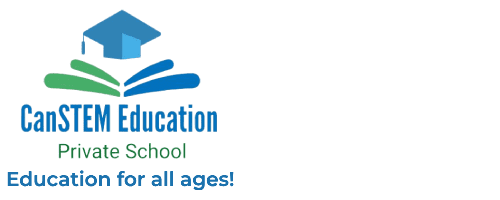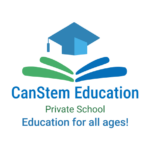Student Achivement And the Assessment and Evaluation Policy –
For CanSTEM Education Private School is consistent with Ministry policy and reflects the vision that CanSTEM Education Private School has which is that the primary purpose of assessment is to improve student learning. Assessment is the process of gathering information that accurately reflects how well a student is achieving the curriculum expectations in a subject or course. Assessment for the purpose of improving student learning is seen as both “assessment for learning” and “assessment as learning”. As part of assessment for learning, teachers provide students with descriptive feedback and coaching for improvement. Teachers engage in assessment as learning by helping all students develop their capacity to be independent, autonomous learners who are able to set individual goals, monitor their own progress, determine next steps, and reflect on their thinking and learning. Ongoing per-assessments and formative assessments will be used to provide meaningful feedback about student progress and achievement in order to improve performance. Summative assessments will be used to arrive at the grade.
-Reporting Student Achievements :-
Student achievement must be communicated formally to students by means of a report card. The report card provides a record of a student’s achievement of the curriculum expectations. The percentage grade represents the student’s overall achievement of the expectations for the course and reflects the corresponding level of achievement as described in the achievement chart of the discipline.
The final grade for each course is determined as follows:
70% will be based on evaluations conducted throughout the course. This portion of the grade should reflect the student’s most consistent level of achievement throughout the course, although special consideration should be given to more recent evidence of achievement.
30% will be based on final evaluation in the form of an examination, performance, essay, and /or other method of evaluation suitable to the course content and administered towards the end of the course.
Percentage grades below 50% indicate insufficient achievement of curriculum expectations and signal that additional learning is required before the student can achieve the expectations to a passing level. At the end of a course, a student who receives a grade below 50% will not receive credit for the course.
Course evaluation will be divided into two parts: 70% is based on cumulative evidence of summative evaluations undertaken throughout the semester; -30% is based on final evaluations which will take place in the final third of the course.
Final evaluations may or may not include an exam depending on individual course curriculum policy documents. At the beginning of the course, students will receive course outlines that will include detailed assessment and evaluation information, and that also outline the percentage breakdown for both the 70% and the 30%.
All courses will be evaluated according to the following breakdown:
Term work: 70% [based on Knowledge and Understanding, thinking and Investigation, Communication and Application]
Final Summatives 30% [based on Knowledge and Understanding, thinking and Investigation, Communication and Application] Although each course will have the same breakdown, individual courses may have subject specific summative tasks that will be used to determine the student’s grade. Please refer to the course outline as it is presented in your courses for more details.
-Second Chance Protocol :-
Based on the premise that the primary purpose of assessment and evaluation is to improve student learning, students will be given additional opportunities to demonstrate their learning if they are not successful on their first attempt. It will be at the teacher’s discretion and professional opinion on when to exercise this option.
-Repetition of a Course
- Only one credit is earned if course is repeated
- In Grade 11 and 12, an “R” appears on the student’s OST for the course with the lower mark
-Requesting Course Changing
Course transfer policy: A student who registers and is enrolled into a course for less than a week and does not complete an assessment in the course, may request to be transferred to another course. Students will only be granted one course transfer per enrollment. All course transfer requests must come within one week of the initial enrollment. The decision of the CanSTEM Education Private School’s Principal will be considered final in all cases involving student requests for course transfers
-Reporting Student Achievement:-
CanSTEM Education Private School will use the Provincial Report Card, Grades 9-12, for formal written reports sent home two times over the duration the student is active in the course. The first report reflects student achievement of the overall curriculum expectations during the first reporting period, as well as development of the learning skills and work habits. The final report reflects 6 achievement of the overall expectations for the entire course, as well as development of the learning skills and work habits.
-Learning Skills :-
The following Learning Skills guideline will be used by online teachers when assessing students
Learning Skills:
Learning Skills and Habits | Sample Behaviours |
Responsibility | The Student • Fulfill responsibilities and commitments within the learning environment; • Completes and submits class work, homework, and assignments according to the agreed-upon timelines; • Take responsibilities for and manages own behavior. |
Organization | The Student • Devises and follows a plan and process for completing work and tasks; • Establishes priorities and manages time to complete tasks and achieve goals; • Identifies, gathers, evaluates, and uses information, technology, and resources to complete tasks |
Independent Work | The Student • Independently monitors, assess, and revises plans to complete tasks and meet goals; • Uses class time appropriately to complete tasks; • Follows instructions with minimal supervision |
Collaboration | The Student • Accepts various roles and an equitable share of work in a group; • Responds positively to the ideas, opinions, values, and traditions of others; • Builds healthy peer-to-peer relationship through personal and media-assisted interactions; • Works with others to resolve conflicts and build consensus to achieve group goals; • Share information, resources, and expertise and promotes critical thinking to solve problems and make decisions |
Initiate | The Student • Looks for and acts on new ideas and opportunities for learning; • Demonstrates the capacity for innovation and a willingness to take risks; • Demonstrates curiosity and interest in learning; • Approaches new tasks with a positive attitude; • Recognizes and advocates appropriately for the rights of self and others |
Self-Regulation | The Student • Set own individual goals and monitors progress towards achieving them; • Seek clarification or assistance when needed; • Assesses and reflects critically on own strengths, need, and interests; • Identifies learning opportunities, choices, and strategies to meet personal needs and achieve goals; • Perseveres and makes an effort when responding to challenges. |


